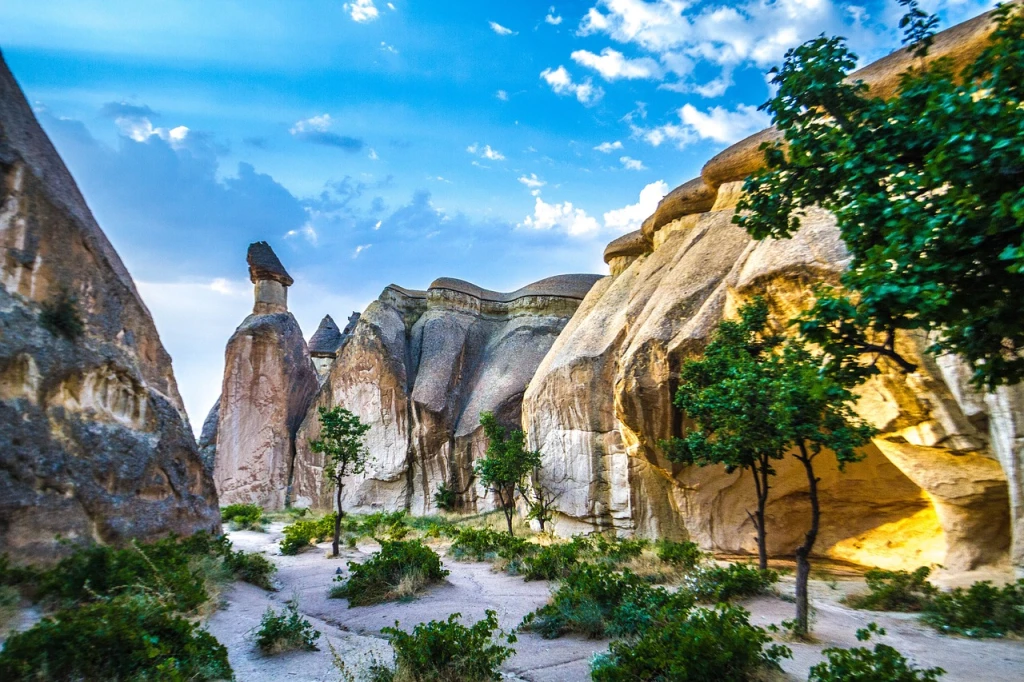Pasabag Valley, also called "Monks Valley," stands out as a widely-visited Cappadocia
region between Avanos and Goreme. It's recognized as one of the must-see spots in
Cappadocia, allowing travelers to witness fairy chimneys resembling mushrooms featuring
multiple stems and caps.
Here is important information about Pasabag Valley;
➢ Pasabag Monks Valley resides within the UNESCO World Heritage Site of Goreme
National Park and the Rock Sites of Cappadocia.
➢ The valley is renowned for its peculiar rock structures, often dubbed "fairy chimneys,"
shaped by volcanic activity and erosion.
➢ The "Monks Valley" finds its roots in the Byzantine era, as monks once inhabited the
rock-carved chambers within the valley.
➢ Pasabag is recognized for its vineyards and the ancient tradition of winemaking, dating
back to the Hittite period. Some of these vineyards still grace the valley today.
➢ Visitors can wander through the valley, explore the unique rock formations, hike along
its trails, and visit the central chapel.
➢ The valley's chapel is dedicated to St. Simeon, a monk known for his ascetic lifestyle
and residing in a small cell atop a pillar. Constructed in the 10th century, the chapel is
one of the valley's oldest buildings.
➢ Pasabag Monks Valley is a sought-after destination for photographers, capturing the
enchanting rock formations and breathtaking vistas, making it one of Cappadocia's
most photographed locations.
➢ Besides its geological wonders, the valley hosts cafes and souvenir shops, offering a
chance for visitors to acquire unique gifts and keepsakes.
PASABAG VALLEY’S HISTORY
Pasabag Valley is renowned for its distinctive and captivating rock formations, often likened
to mushroom-shaped fairy chimneys. The valley's historical roots trace back to the early
Christian era, serving as a sacred site for monks over centuries.
In the Byzantine period, monks seeking solace from religious persecution found sanctuary in
the valley, carving out cave dwellings and chapels within the malleable tuff rock formations.
A testament to their presence, a small chapel adorned with frescoes depicting the life of St.
Simeon and other Christian figures still graces the valley.
The name "Pasabag" is a fusion of the Persian words "paşa" (meaning "general" or
"leader") and "bağ" (meaning "garden"). Legend has it that a Persian general once
sojourned in the valley reveling in its scenic beauty. Beyond its historical and cultural allure,
Pasabag boasts natural beauty and breathtaking panoramic vistas. Travelers can explore the
valley by foot, ascending and descending the distinctive rock formations, savoring the sight of
the expansive landscape and the charming vineyards adorning the valley floor.
YOU CAN SEE & DO IN PASABAG VALLEY
Most Cappadocia visitors go to Pasabag Valley to witness the mesmerizing fairy chimney
formations. Once a haven for monks seeking solitude, these formations have become a
captivating tourist destination in Cappadocia.
A delightful activity in the valley is to immerse oneself in nature and its unique beauty by
strolling amid the fairy chimneys. This valley, once a refuge for priests and monks, harbors
numerous rock-cut monasteries, churches, chapels, settlements, tunnels, and mills.
Fairy chimneys, molded by the potent combination of strong winds, precipitation from valley
slopes, and floodwaters that sculpt the tuff structures of the region, showcase a mushroom-
like appearance here. Upon entering the valley, a prominent walking track unfolds, offering
the pleasure of soaking in the scenic beauty adorned with numerous fairy chimneys.
At the heart of the valley lies the renowned fairy chimney chapel a trinity-capped structure
where Saint Simeon secluded himself for 15 years.
